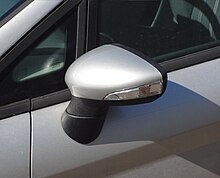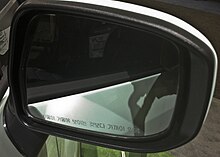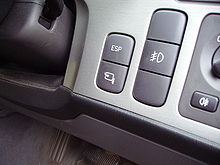Lr 3 Lh Side Mirror and Backing Plate

Dual-contour side mirror. Large inboard convex surface is separated from small outboard aspheric surface.

Side mirror with integrated turn signal repeater

Side mirror with warning legend
A side-view mirror (or side mirror), also known as a wing mirror, is a mirror placed on the exterior of motor vehicles for the purposes of helping the driver see areas behind and to the sides of the vehicle, outside the driver's peripheral vision (in the "blind spot").
Almost all modern cars mount their side mirrors on the doors—normally at the A-pillar—rather than the wings (the portion of the body above the wheel well).
The side mirror is equipped for manual or remote vertical and horizontal adjustment so as to provide adequate coverage to drivers of differing height and seated position. Remote adjustment may be mechanical by means of bowden cables, or may be electric by means of geared motors. The mirror glass may also be electrically heated and may include electrochromic dimming to reduce glare to the driver from the headlamps of following vehicles. Increasingly, the side mirror incorporates the vehicle's turn signal repeaters. There is evidence to suggest that mirror-mounted repeaters may be more effective than repeaters mounted in the previously predominant fender side location.[1]


Driver's control for side mirrors, with tiny curb-view button
Optional side mirror [edit]
In the 1940s, many roads were unpaved and had two lanes, one in each direction. Drivers had to be aware only of traffic on their side and directly behind them (rear view). Due to this, most passenger vehicles with an internal rear-view mirror until the late 1960s had the passenger-side mirror only as an optional addition, as it was considered a luxury.
Planar, convex, aspheric [edit]
In the U.S. and Canada, the U.S. National Highway Traffic Safety Administration's Federal Motor Vehicle Safety Standard 111 and the Canada Motor Vehicle Safety Standard 111 require the driver-side mirror to provide "unit magnification", i.e., an undistorted 1:1 reflection achieved with a flat mirror. However, unit magnification limits the field of view that can be provided by a mirror of size compatible with the vehicle body. The ECE regulations in use throughout most of the world except North America permit the driver-side mirror to have a planar, convex, or aspheric surface; an aspheric section is often combined with a larger convex section, and the two sections are separated by a visible line to alert the driver to the two sections' different perspective shifts.[2] [3]
Because of the distance from the driver's eye to the passenger side mirror, a useful field of view can be achieved only with a convex or aspheric mirror. However, the convexity also minifies the objects shown. Since such objects seem farther away than they actually are, a driver might make a maneuver such as a lane change assuming an adjacent vehicle is a safe distance behind, when in fact it is quite a bit closer.[4] In the United States,[5] Canada,[6] India, Korea and Australia[ citation needed ], non-planar mirrors are etched or printed with the warning legend objects in the mirror are closer than they appear. In Canada, this warning is often supplemented by a transparent decal on the passenger side window repeating the warning in French: les objets dans le retroviseur sont plus proche qu'ils ne le paraissent. In Korea, the warning appears in Korean. Warnings of this nature are not required in Europe.

Side mirror retraction control
Other requirements [edit]
More commonly in cars manufactured since the 2000s, side mirrors may be manually or electrically folded in, to protect them when the car is parked or being washed in an automated car wash.[ citation needed ] Passing cars can easily clip protruding side mirrors; the folding capability helps protect them from harm. ECE Regulation 46 requires that side mirrors be mounted such that they swing away when struck by a test cylinder meant to represent a pedestrian.[7]
Until March 1983, the Japanese Ministry of Transport did not allow cars to be registered without mirrors on front fenders,[8] so the mirrors were mounted far forward atop the front fenders. More recent Japanese-specification vehicles have side mirrors similar to those in other countries.[9] Taxi drivers and other professional drivers retain a preference for the wing-mounted mirrors as they feel that they work better in extremely tight traffic.[9]
U.S. Federal Motor Vehicle Safety Standard 111 requires that convex side-view mirrors must have a curvature radius of between 889 mm and 1651 mm.[5] Canada Motor Vehicle Safety Standard 111 stipulates a range of between 890 mm and 1800 mm.[6] Neither the U.S. nor the Canadian standard allows for aspheric mirrors.[3] The European ECE Regulation 46 used throughout most of the world permits planar, convex, and/or aspheric mirrors on either side of the vehicle.[3] [7] American research suggests non-planar driver side mirrors may help reduce crashes.[2] [10]
Digital [edit]
In 2018, side mirrors in a form of camera and display were introduced for a better peripheral recognition upon driving. It has advantages over conventional ones as it provides wider angle of sight and less air resistance without obstructing driver's frontal view. These side mirrors are applied to various types of vehicles such as Hyundai Ioniq 5, Audi e-tron.
See also [edit]
- Automatic parking
- Backup collision
- Backup camera
- Blind spot monitor
- Blind spot (vehicle)
- Intelligent Parking Assist System
- Experimental Safety Vehicle (ESV)
- Intelligent car
- Lane departure warning system
- Objects in mirror are closer than they appear - Discusses use of the safety warning as a catch phrase in other contexts.
- Precrash system
- Rear-view mirror
- Power side-view mirror
References [edit]
- ^ Flannagan, M.J.; Reed, M.P. (2005). "Geometric Visibility of Mirror-Mounted Turn Signals". Ref 2005-01-0449. Society of Automotive Engineers. Archived from the original (paper, PDF) on 30 September 2007. Retrieved 14 August 2006.
- ^ a b "Are Convex Driver Side Mirrors Helpful or Harmful?" (PDF). umich.edu . Retrieved 19 April 2018.
- ^ a b c "Synthesis Study of Light Vehicle Non-Planar Mirror Research" (PDF). nhtsa.gov . Retrieved 19 April 2018.
- ^ Skorucak, Anton. "Why does the passenger side window on my car state 'objects in mirror are closer than they appear?". physlink.com . Retrieved 19 April 2018.
- ^ a b "Standard No. 111; Rearview mirrors". edocket.access.gpo.gov . Retrieved 19 April 2018.
- ^ a b "Canada Motor Vehicle Safety Standard 111". tc.gc.ca . Retrieved 19 April 2018.
- ^ a b "Text of the 1958 Agreement - Transport - UNECE" (PDF). www.unece.org . Retrieved 19 April 2018.
- ^ Mainichi Shimbun 19 March 1983 morning p. 22
- ^ a b Gordenker, Alice (18 November 2013). "Fender mirrors". Archived from the original on 2 April 2019 – via Japan Times Online.
- ^ "Response times using flat, convex, and multiradius rearview mirrors" (PDF). umich.edu . Retrieved 19 April 2018.
Lr 3 Lh Side Mirror and Backing Plate
Source: https://en.wikipedia.org/wiki/Side-view_mirror
0 Response to "Lr 3 Lh Side Mirror and Backing Plate"
Post a Comment